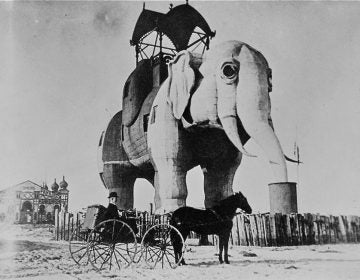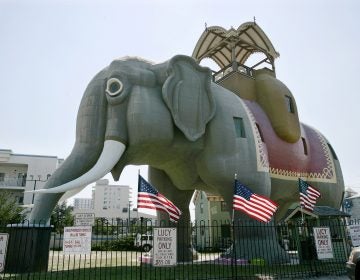Bad weather and supply chain delays completion of Lucy the Elephant’s makeover
While the nation’s oldest roadside attraction in Margate will be open for tours starting Memorial Day weekend, Lucy will not be seen in her new skin until mid-August.

Lucy the Elephant is a tourist attraction in Margate, N.J. (AP Photo/Brian Branch-Price)
This story was updated on April 25 to include a photo of the scaffolding surrounding Lucy the Elephant taken on this date.
Lucy the Elephant’s makeover is taking longer than expected.
While the nation’s oldest roadside attraction in Margate will be open for tours starting Memorial Day weekend, Lucy will not be seen in her new skin until mid-August.
The pandemic affected the timeline, and supply chain issues delayed the acquisition of proper materials for the project. Richard Helfant, executive director and CEO of the Save Lucy Committee, said bad weather also played a role.
“This has been the worst weather in recent memory,” he said of the conditions from this past winter and into the spring. “I don’t think we’ve had one weekend where the scaffolding hasn’t been torn apart by high winds.”
For example, 30% of the containments, which protects the exposed wood from the elements, were lost due to high winds on Monday.
The weather has exacerbated what was supposed to be a simple task of stripping paint off Lucy’s exterior to re-coat her. Helfant said it has now grown into a “mammoth project” that has doubled in cost to more than $2 million.
When Lucy’s caretakers were preparing to re-coat her in the summer of 2020, damage to the existing metal was discovered.
“The metal is so badly rotted in more than 50% of the elephant that the architects and the engineers decided that the proper thing to do is to remove all the metal and replace it,” Helfant said.
Now she’s getting a body lift. But because Lucy is a state and national historic landmark, and because the project is being funded, in part, by the government, strict guidelines must be adhered to. A historic restoration architect approves everything that is done on the project.
They had to wait for Lucy’s new metal to come in, which delayed the project for three months. It’s now on site.
Once the new metal is on her, the contaminants can protect her new paint job from sand until it completely dries. The paint being used for the project costs $458 a gallon.
“You can imagine how many gallons of paint it takes to paint a six-story elephant,” Helfant remarked.
Most of the cost is being covered by government funding, but the committee needs to raise another $800,000 to meet its goal. Helfant says a major capital campaign will launch in the next two to three weeks.
Tours will resume as the work is being completed. Visitors will still be able to go inside of Lucy, but the riding carriage or howdah will not be open due to the scaffolding.

Helfant hopes that the scaffolding comes down and the work is completed sooner than mid-August, but is cautious.
“We’re always optimistic that they’ll finish sooner, but we’re also realistic that they probably won’t,” he said. “There’s so many variables as they progress with the metal replacement and discover more rotted wood than we had originally anticipated,” adding that there are also weather issues to contend with due to Lucy being 100 feet from the beach.
Disclaimer: Lucy the Elephant is a WHYY underwriter.
WHYY is your source for fact-based, in-depth journalism and information. As a nonprofit organization, we rely on financial support from readers like you. Please give today.






